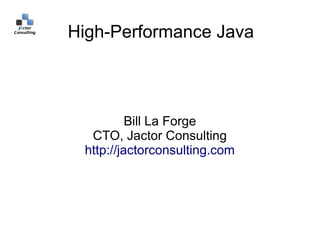High performance-java
•Download as ODP, PDF•
4 likes•3,969 views
A guide to writing high-performance Java code.
Report
Share
Report
Share

Recommended
Recommended
More Related Content
Viewers also liked
Viewers also liked (19)
Java Performance, Threading and Concurrent Data Structures

Java Performance, Threading and Concurrent Data Structures
Practical Steps For Building High Performance Teams

Practical Steps For Building High Performance Teams
WSO2 Identity Server 5.3.0 - Product Release Webinar

WSO2 Identity Server 5.3.0 - Product Release Webinar
High Performance Flow Matching Architecture for Openflow Data Plane

High Performance Flow Matching Architecture for Openflow Data Plane
Java Performance Analysis on Linux with Flame Graphs

Java Performance Analysis on Linux with Flame Graphs
SAML / OpenID Connect / OAuth / SCIM 技術解説 - ID&IT 2014 #idit2014

SAML / OpenID Connect / OAuth / SCIM 技術解説 - ID&IT 2014 #idit2014
15 Years of Web Security: The Rebellious Teenage Years

15 Years of Web Security: The Rebellious Teenage Years
Java Performance: Speedup your application with hardware counters

Java Performance: Speedup your application with hardware counters
More from Bill La Forge (6)
Recently uploaded
Recently uploaded (20)
Navigating the Deluge_ Dubai Floods and the Resilience of Dubai International...

Navigating the Deluge_ Dubai Floods and the Resilience of Dubai International...
Elevate Developer Efficiency & build GenAI Application with Amazon Q

Elevate Developer Efficiency & build GenAI Application with Amazon Q
Polkadot JAM Slides - Token2049 - By Dr. Gavin Wood

Polkadot JAM Slides - Token2049 - By Dr. Gavin Wood
Six Myths about Ontologies: The Basics of Formal Ontology

Six Myths about Ontologies: The Basics of Formal Ontology
Strategize a Smooth Tenant-to-tenant Migration and Copilot Takeoff

Strategize a Smooth Tenant-to-tenant Migration and Copilot Takeoff
Apidays New York 2024 - The Good, the Bad and the Governed by David O'Neill, ...

Apidays New York 2024 - The Good, the Bad and the Governed by David O'Neill, ...
ICT role in 21st century education and its challenges

ICT role in 21st century education and its challenges
Apidays New York 2024 - APIs in 2030: The Risk of Technological Sleepwalk by ...

Apidays New York 2024 - APIs in 2030: The Risk of Technological Sleepwalk by ...
Apidays New York 2024 - Accelerating FinTech Innovation by Vasa Krishnan, Fin...

Apidays New York 2024 - Accelerating FinTech Innovation by Vasa Krishnan, Fin...
Connector Corner: Accelerate revenue generation using UiPath API-centric busi...

Connector Corner: Accelerate revenue generation using UiPath API-centric busi...
CNIC Information System with Pakdata Cf In Pakistan

CNIC Information System with Pakdata Cf In Pakistan
High performance-java
- 1. High-Performance Java Bill La Forge CTO, Jactor Consulting http://jactorconsulting.com
- 2. High-Performance Java ● When is it needed? ● Development Methodology ● High-Performance Considerations
- 3. When is it Needed? ● Most Java code is fast enough for its intended use. ● When optimization is needed, it is usually best done after the code is debugged. ● But when the utility of the code is directly linked to its performance, the development of high- performance code can sometimes justify the expense of its development.
- 4. Development Methodology ● A test-centric approach is needed to identify non-performant code early in the development cycle. ● Performance testing is needed in both unit testing and system testing. ● For critical sections of code it is sometimes better to duplicate code instead of subclassing. But a small memory footprint may be more important. Finding the most performant compromises requires performance testing.
- 5. High-Performance Considerations ● Algorithms ● JIT ● Garbage Collection ● Multi-Threading ● Memory Architecture
- 6. Algorithms ● There is no best algorithm or best data structure, only best fit for a specific context. ● Algorithms which fit in high-speed cache may perform better than expected. ● Array backed data structures shared across threads may work better than linked data structures. ● Critical performance considerations are often opaque, with performance testing the only recourse.
- 7. JIT ● Methods with bytecode longer than 60 bytes are NOT optimized, so adding a line of code to a method will sometimes result in a dramatic loss of speed. ● Use final classes and final methods where possible. Consider code duplication in place of subclassing for critical sections. ● Performance tests should exercise code heavily before doing any timings to ensure that the JIT has compiled the bytecode under test.
- 8. Garbage Collection ● Garbage collection is a common cause for non- performant code. ● Minimize object creation within loops. ● Minimize the number of references an object has to other objects. ● Avoid circular structures as much as possible. ● Clear references to objects as soon as possible.
- 9. Multi-Threading ● In general, using a single thread is orders of magnitude faster than using multiple threads, as passing data between threads is comparitively slow. ● When there is justification for passing data between threads, pass as much a possible each time. For example, use a pipeline where backpressure from the next stage is used to control the amount of data being passed. ● When passing data between threads, flow control is critical for good overall performance.
- 10. Memory Architecture ● When using a thread pool, remember that the code and the data will need to be loaded into the CPU's local cache, making for a slow start when a thread is allocated a task. And having more CPUs only makes this worse. ● Linked data structures make for frequent cache misses, which is why table-backed sturctures are often faster. ● Sharing data blocks between threads, especially when more than one thread does the updates, will slow things down—even if the same data within a block is not being shared.